2. 中国地质科学院地球物理地球化学勘查研究所, 廊坊 065000;
3. 中国地质调查局土地质量地球化学调查评价研究中心, 廊坊 065000;
4. 中国地质调查局地球表层碳-汞地球化学循环重点实验室, 廊坊 065000;
5. 中国地质科学院地球表层碳-汞地球化学循环重点实验室, 廊坊 065000
2. Institute of Geophysical & Geochemical Exploration, Chinese Academy of Geological Sciences, Langfang 065000, China;
3. Research Center of Geochemical Survey and Assessment on Land Quality, China Geological Survey, Langfang 065000, China;
4. Key Laboratory of Geochemical Cycling of Carbon and Mercury in the Earth's Critical Zone, China Geological Survey, Langfang 065000, China;
5. Key Laboratory of Geochemical Cycling of Carbon and Mercury in the Earth's Critical Zone, Chinese Academy of Geological Sciences, Langfang 065000, China
由于Hg、As、Pb、Cd、Cu、Zn、Ni和Cr等微量元素的毒性、持久性和不可生物降解等特性, 其在河流生态系统中的环境行为引起了广泛关注[1~3].泛滥平原是水生、半水生和陆生环境相互连接不断变化的镶嵌区域, 是陆地上最具生产力和异质性的生态系统之一[1], 在全球范围内约占陆地面积的1.3%[4].泛滥平原上的土壤是由周期性洪水搬运和沉积的物质发育而成, 土壤连同河流沉积物和河水一起可能接收了来自工业、农业活动或自然风化的溶解性和颗粒性物质/污染物的输入[5, 6].已有研究发现在许多河流沿岸的泛滥平原土壤中积累了各种有机和无机污染物[1, 7~10].由于泛滥平原处于河流系统的地貌敏感区且表现出强烈的空间和季节异质性, 它们既是微量金属的汇, 又是微量金属的源[3, 8].从地球化学填图的观点来说, 泛滥平原沉积物可代表较大的汇水盆地, 对整个流域疏松沉积物成分具有充分的代表性[11~14].因此, 泛滥平原沉积物中保存的地球化学记录可以让人们进一步了解流域的污染历史, 对河流污染防治和改善流域生态系统环境质量具有重要意义.
工业化、城市化和集约化农业等人类活动改变着人们赖以生存的环境, 20世纪80年代以来, 伴随我国经济快速增长而出现的生态系统环境质量问题日趋显著.鄱阳湖是我国第一大淡水湖, 入湖水系由赣江、抚河、信江、饶河和修水等五大主要河流组成.由于工业或矿业活动和农业面源污染等原因, 鄱阳湖流域的环境质量遭遇了严峻的挑战.多年来, 为了监测和评估鄱阳湖及其流域的环境质量状况, 开展了湖泊沉积物、河流沉积物和河流悬浮物等介质中的微量元素污染程度调查和生态风险评价[15~31], 但鲜见有从流域尺度监测泛滥平原沉积物中微量元素的含量、污染水平及生态风险的时空变化.
本文采用鄱阳湖流域5条主要支流泛滥平原沉积物2期间隔近20 a的数据, 对Cd、Hg、Pb、As、Cu、Zn、Cr、Ni、Mn、Sb、W和Sn等12种微量元素含量、污染水平和生态风险的时空变化进行研究, 并对污染水平显著变化区域的污染源进行了分析和探讨.采用富集因子(EF)和修正综合污染指数(MPI)评价了微量元素的污染程度; 应用潜在生态风险因子(Er)和修正生态风险指数(MRI)量化了沉积物中微量元素引发的生态风险, 以期为鄱阳湖流域生态系统的优化管理提供科学依据.
1 材料与方法 1.1 研究区概况鄱阳湖位于江西省北部, 是我国最大的淡水湖, 它北连长江, 赣江、抚河、信江、饶河和修水等五大河流, 是鄱阳湖的主要入湖水系(图 1).赣江是鄱阳湖水系第一大河, 包括章水和贡水两大源流, 由南到北纵贯整个江西中部地区, 全长约751 km, 流域面积约8.35×104 km2; 赣江流域分为上、中、下游, 上游流经矿产资源丰富的地区, 中游流经吉泰盆地水稻种植区, 下游流经宜春、新余和南昌等城市.抚河全长约312 km, 流域面积约1.58×104 km2; 信江全长约313 km, 流域面积约1.59×104 km2; 饶河由乐安江和昌江南北两大支流汇合而成, 流域面积约1.55×104 km2; 修水全长约357 km, 流域面积约1.40×104 km2.鄱阳湖流域内矿产资源丰富, 分布有乐安江中下游的德兴铜矿, 信江中游的永平铜矿和赣南有色金属矿区等.
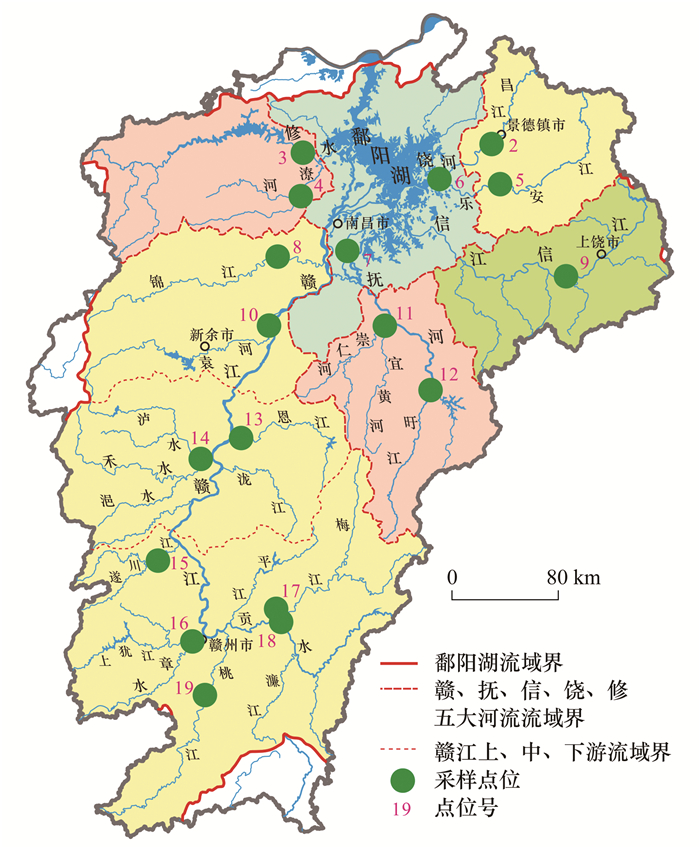
|
图 1 鄱阳湖流域泛滥平原沉积物采样点位示意 Fig. 1 Locations of the floodplain sediment sampling sites in the Poyang Lake basin |
在中国土壤环境质量地球化学监控网络(1992~1995年)[32]的基础上, 分别于1994年和2015年在鄱阳湖流域五大入湖水系18个超级汇水盆地出口处采集泛滥平原沉积物样品, 采样深度5~25 cm(图 1).2期样品(1994年的样品是一直保留至今的副样)均经自然干燥, 初加工后过10目尼龙筛, 送实验室进一步加工和分析检测.
1.3 分析方法和质量控制2期样品在实验室进行同批次分析.样品混匀后用无污染球磨机粉碎至200目粒度以备分析测试.采用X射线荧光光谱法(XRF)测定样品中的Cr、Mn和Al; 电感耦合等离子体质谱法(ICP-MS)测试Cd、Cu、Ni、Pb、W和Zn; 原子荧光光谱法(AFS)测试Sb、As和Hg; 发射光谱法(ES)测试Sn.样品测试按照分析质量控制要求插入了5种国家一级标准物质(GSS21、GSS22、GSS25、GSS26和GSS27)[33], 其准确度和精密度合格率均达到100%.
1.4 富集因子(EF)富集因子(EF)已被广泛用于评估土壤、河流和湖泊沉积物等介质中微量元素的污染状况, 并可区分人为来源和自然来源.计算需选用参考元素对目标元素进行地球化学归一化, EF计算公式如下[34]:

|
式中, Cn和Cref分别是泛滥平原沉积物中元素n和归一化参考元素的实测含量, Bn和Bref分别是江西省土壤元素背景值中元素n和归一化参考元素的含量[35].Al是在地壳中自然丰度高的主量元素, 一般不受人为输入的影响, 且鄱阳湖流域泛滥平原沉积物中Al含量的空间变异较小, 因此本文选用Al作为地球化学归一化元素.
当元素的EF值小于或接近1时, 被认为是源于自然作用过程, EF值高于1.5则表明受人为源的影响.根据EF值可将污染等级划分为5级: EF≤2, 无或轻微污染; 2 < EF≤5, 中度污染; 5 < EF≤20, 中度-重度污染; 20 < EF≤40, 重度污染; EF>40, 极度污染[36].
1.5 修正综合污染指数(MPI)基于尼梅罗污染指数(PI), Brady等[37]提出了一种适用于河口和海洋沉积环境的修正综合污染指数(MPI)的计算方法, 并得到广泛应用[38, 39].此方法的优点是既考虑了河口沉积物中微量元素的自然变化, 并且弥补了沉积物中矿物的天然粒度变异和多种沉积物源的可能性, 又调整了沉积物限定阈值以提供更准确的限定[37, 40]. MPI计算公式如下:

|
式中, EF和EFmax分别是泛滥平原沉积物中12种微量元素EF的算数平均值和极大值.MPI是基于EF计算的, 以EF阈值作为MPI分级的基础, MPI < 1、1~2、2~3、3~5、5~10和>10的沉积物分别被划分为未污染、轻度污染、中度污染、中度-重度污染、重度污染和极度污染等级[37].
1.6 修正生态风险指数(MRI)Håkanson[41]于1980年提出了潜在生态风险指数(RI)的计算方法, 其目标主要是用于水污染控制的评估.此方法综合考量了介质中微量元素的含量、毒性及敏感性因素, 为定量评估环境介质的综合污染风险提供了参考, 现已广泛应用于评估水、土壤及沉积物等介质中微量元素的潜在生态风险.RI计算公式如下[41]:

|
由于RI在计算中使用污染因子(Cfi), 没有考虑陆相沉积作用过程的自然变化和粒度等影响因素, 尤其对河口沉积环境的风险评估具有一定的局限性.鉴于上述原因, 为了更准确地评估沉积物的生态风险水平, 有学者提出用富集因子(EFi)代替污染因子(Cfi)计算生态风险指数, 即修正生态风险指数(MRI)[42], 且在相关研究领域得到了应用[17, 43].MRI计算公式如下:

|
式中, Tri是元素i的毒性反应因子, 其诠释了毒性和敏感性要求, Hg、Cd、As、Pb、Cu、Cr和Zn元素的Tri分别为40、30、10、5、5、2和1; Cfi是元素i的污染因子; Eri是元素i的潜在生态风险因子, 分级标准见表 1; EFi是元素i的富集因子; MRI是修正生态风险指数代表沉积物中微量元素引发的风险之和.
|
|
表 1 潜在生态风险因子(Eri)和修正生态风险指数(MRI)的分级标准 Table 1 Classification of potential ecological risk factor (Eri) and modified ecological risk index (MRI) |
Håkanson是根据PCB、Hg、Cd、As、Pb、Cu、Cr和Zn等8个指标提出RI等级划分的阈值, 本文研究了其中7种微量元素(未涉及PCB指标), 基于这些指标的参考值, 调整后的MRI分级标准[44]见表 1.
本文使用Microsoft Excel 2010和SPSS 19对数据进行统计分析, 使用Surfer 12、ArcGIS 10.4和CorelDRAW X7制作图件.
2 结果与讨论 2.1 含量特征鄱阳湖流域泛滥平原沉积物中Cd、Hg、Pb、As、Cu、Zn、Cr、Ni、Mn、Sb、W和Sn等12种微量元素含量的统计值和参考值见表 2.
|
|
表 2 鄱阳湖流域泛滥平原沉积物中微量元素含量的统计汇总和参考值/mg·kg-1 Table 2 Summary of the statistics and reference values of trace element concentrations in floodplain sediments of the Poyang Lake basin/mg·kg-1 |
1994年, 12种微量元素含量的中位值分别为0.13、0.106、36.2、10.4、22.9、70.5、56.5、20.5、440.6、0.85、3.0和7.4 mg·kg-1, 高于江西省土壤元素背景值的点位比例分别为94%、78%、78%、33%、78%、56%、78%、83%、89%、44%、28%和94%.其中Cd、Hg、Mn和Sn的中位值分别为背景值的1.79、1.52、1.97和1.57倍, Hg、Sb和W的变异系数均大于1, 表明流域内存在高含量异常值.鄱阳湖流域Hg的极大值出现在抚河旴江点位(12号), 含量为1.282 mg·kg-1, 高达背景值的18.3倍, Hg在抚河下游点位(7号)的含量较高, 是背景值的6.3倍; Sb的极大值出现在赣江上游贡水点位(18号), 含量为33.41 mg·kg-1, 高达背景值的35.5倍; W的极大值出现在赣江上游章水点位(16号), 含量为23.0 mg·kg-1, 是背景值的5倍.
2015年, 12种微量元素含量的中位值分别为0.31、0.069、39.0、8.8、22.9、89.1、43.9、18.4、622.3、0.74、3.7和6.5 mg·kg-1, 高于背景值的点位比例分别为94%、50%、83%、28%、67%、78%、50%、72%、100%、22%、44%和94%.其中Cd和Mn的中位值分别为背景值的4.18和2.78倍, Cd、Cu和W的变异系数均大于0.89, 表明流域内存在高含量异常值.鄱阳湖流域Cd的极大值出现在饶河乐安江点位(5号), 含量高达1.42 mg·kg-1, 其连同赣江上游桃江点位(19号)和赣江下游锦江点位(8号)Cd含量均达到背景值的12倍以上; Cu的极大值出现在饶河乐安江点位(5号), 含量为248.7 mg·kg-1, 高达背景值的13.4倍; W的极大值出现在赣江上游章水点位(16号), 含量为49.2 mg·kg-1, 是背景值的10.7倍.
近20年来, 12种微量元素含量总体上增加的是Cd、Zn、Mn、W和Pb, 分别升高了134%、26%、41%、25%和8%; 总体上减少的是Hg、As、Cr、Ni、Sb和Sn, 分别降低了35%、15%、22%、10%、14%和13%; Cu无明显变化(表 2和图 2).Cd在饶河、赣江和信江流域显著升高, 分别升高了331%、151%和107%; Zn在饶河流域明显升高, 升高了91%; Mn在抚河、赣江和饶河流域明显升高, 分别升高了87%、73%和66%; W在抚河和赣江流域明显升高, 升高了92%和59%; Hg在抚河、赣江和修水流域分别降低了87%、41%和40%.
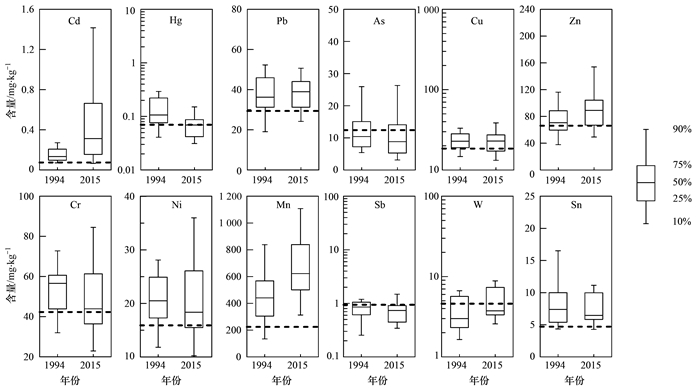
|
图 2 鄱阳湖流域泛滥平原沉积物中12种微量元素含量箱型图 Fig. 2 Boxplots for the concentrations of twelve trace elements in floodplain sediments of the Poyang Lake basin for two periods |
饶河流域12种微量元素含量均显示出不同程度的增长, 其中Cd和Cu升高了331%和166%, Hg、As和Zn升高均超过90%, Ni、Mn和Sb升高均超过50%.饶河乐安江点位(5号)显示出多元素含量的高幅增长, 其中Cu和Cd升高了703%和421%, As、Zn和Hg分别升高了180%、168%和137%.在修水流域, 除了W含量略有升高外, 其他11种微量元素含量均出现不同程度的降低.
2.2 污染水平1994年, 12种微量元素EF中位值排序为Mn(2.4)>Cd(2.2)>Sn(1.9)>Ni=Hg(1.7)>Cr=Cu(1.6)>Pb(1.5)>Zn(1.4)>Sb(1.3)>As(1.1)>W(0.8)(图 3), Cd、Hg、Mn和Sn达到中度及以上污染的比例分别为61%、44%、61%和33%, 表明鄱阳湖流域的主要污染元素是Cd、Hg、Mn和Sn.Hg和Sn的中度及以上污染主要分布于赣江流域和抚河流域, Cd和Mn的中度及以上污染在5条主要支流均有分布.12种微量元素的EFmax排序为Sb(31.2)>Hg(24.4)>W(6.1)>Cd(5.5)>Sn(5.2)>Mn(3.9)>As(3.2)>Cu(2.6)>Pb(2.4)>Cr=Ni(2.1)>Zn(1.9), Sb的EFmax出现在赣江上游贡水点位(18号), Hg和Sn的EFmax均出现在抚河盱江点位(12号), W的EFmax出现在赣江上游章水点位(16号), Cd的EFmax出现在饶河乐安江点位(5号).

|
图 3 鄱阳湖流域泛滥平原沉积物中12种微量元素富集因子箱型图 Fig. 3 Boxplots for enrichment factors of twelve trace elements in floodplain sediments of the Poyang Lake basin for two periods |
2015年, 12种微量元素EF中位值排序为Cd(3.9)>Mn(3.1)>Sn(1.6)>Ni=Zn=Cu(1.4)>Pb(1.3)>Cr(1.2)>Hg(1.0)>Sb=W(0.9)>As(0.8)(图 3).Cd的中度及以上污染比例为72%, 其中重度、中度-重度和中度污染比例分别为6%、33%和33%, 整个赣江流域Cd处于中度和中度-重度污染(图 4); Mn的中度污染比例为94%, 表明鄱阳湖流域的主要污染元素是Cd和Mn, 且Cd是主导污染元素.12种微量元素EFmax排序为Cd(21.6)>Cu(15.3)>W(14.2)>Sn(7.0)>Mn(4.7)>Hg(4.0)>Zn(3.7)>As(2.8)>Pb=Ni(2.3)>Sb(2.2)>Cr(1.8), Cd和Cu的EFmax均出现在饶河乐安江点位(5号), W和Sn的EFmax均出现在赣江上游章水点位(16号), 同时该点位的EFCd高达11.8.
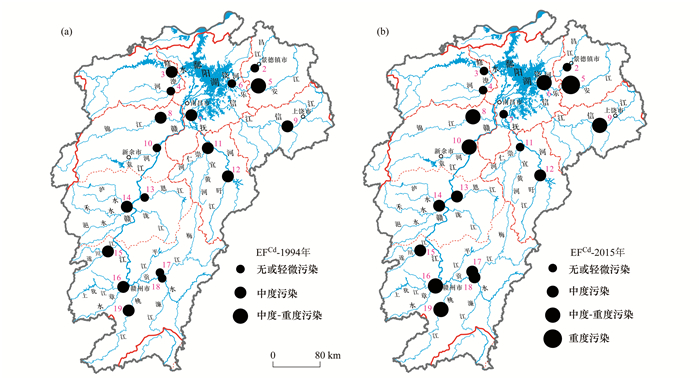
|
图 4 基于EF的鄱阳湖流域泛滥平原沉积物中Cd污染分级 Fig. 4 Classification based on EF for cadmium in floodplain sediments of the Poyang Lake basin |
近20年来, 鄱阳湖流域微量元素的污染水平和污染空间分布发生了变化, 总体表现为Cd污染加剧和Hg污染降级, Mn污染有所提升, 其他元素变化不明显.Cd污染加剧主要表现在EFCd中位值从2.2升至3.9, EFmax从5.5升至21.6, 重度和中度-重度污染点位比例从6%升至39%, 整个赣江流域Cd污染升级至中度和中度-重度, 饶河乐安江点位(5号)Cd污染升级至重度(图 4); Hg污染降级主要表现在EFHg中位值从1.7降至1.0, EFmax从24.4降至4.0, 中度及以上污染点位比例从44%降至11%, 抚河流域Hg污染降至无或轻微(图 5).
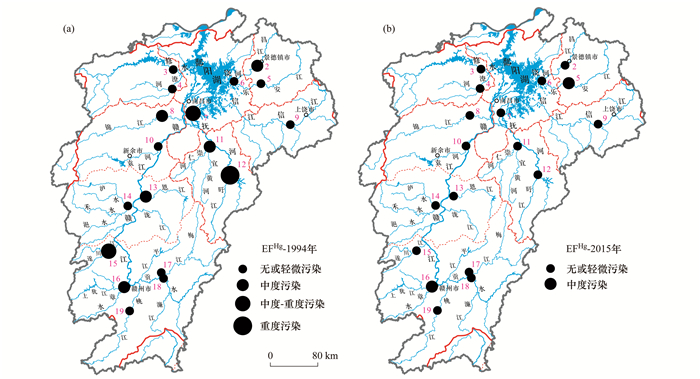
|
图 5 基于EF的鄱阳湖流域泛滥平原沉积物中Hg污染分级 Fig. 5 Classification based on EF for mercury in floodplain sediments of the Poyang Lake basin |
整个赣江流域, Cd污染升级至中度和中度-重度(图 4), 尤其在桃江点位(19号)、章水点位(16号)、袁河点位(10号)和锦江点位(8号)的EFCd分别从3.0、3.9、1.9和2.1升至14.1、11.8、8.6和14.0(图 6); Hg污染水平降低主要表现在EFHg中位值由1.86降至0.94, 且在遂川江点位(15号)、恩江点位(13号)和锦江点位(8号)的污染均降至无或轻微(图 5); Sb在贡水点位(18号)从重度污染降至无或轻微污染; W在桃江点位(19号)从无或轻微污染升至中度污染, 虽然W在章水点位(16号)的污染等级不变, 但W的污染水平明显升高, EFW从6.1升至14.2(图 6).
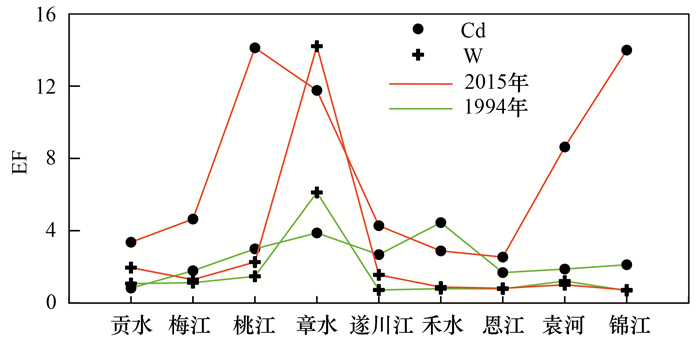
|
图 6 赣江流域两期泛滥平原沉积物中Cd和W富集因子对比 Fig. 6 Comparison of enrichment factors for Cd and W in floodplain sediments of the Ganjiang River basin for two periods |
饶河流域Cd污染升级表现在乐安江点位(5号)的EFCd从5.5升至21.6, 饶河下游点位(6号)的EFCd从1.5升至6.4.乐安江点位(5号)的Cu由中度污染升至中度-重度污染, Hg、As、Zn、Ni和Sb均由无或轻微污染升级至中度污染.
基于MPI的污染分级结果显示, 1994年鄱阳湖流域泛滥平原沉积物极度、重度、中度-重度、中度和轻度污染点位比例分别为11%、6%、28%、44%和11%.极度污染点位分布于赣江上游贡水(18号)和抚河旴江(12号), 主导因素分别为Hg和Sb重度污染; 重度污染点位于抚河下游(7号), 主导因素为Hg中度-重度污染; 中度-重度污染点位分布于赣江和饶河, 其中赣江上游章水点位(16号)为W、Sn、Cd和Hg多元素组合污染, 赣江上游遂川江点位(15号)为Hg、Mn、As和Cd多元素组合污染, 赣江中游禾水点位(14号)和饶河乐安江点位(5号)污染主控元素为Cd和Mn, 饶河昌江点位(2号)为Hg、Mn和Sn组合污染(图 7).
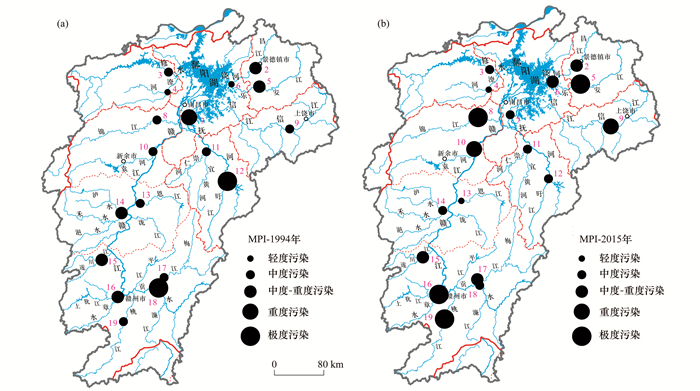
|
图 7 基于MPI的鄱阳湖流域泛滥平原沉积物中微量元素污染分级 Fig. 7 Classification based on MPI for twelve trace elements in floodplain sediments of the Poyang Lake basin |
2015年鄱阳湖流域泛滥平原沉积物极度、重度、中度-重度、中度和轻度污染点位比例分别为22%、11%、22%、33%和11%.极度污染点位分布于赣江和饶河, 其中赣江上游桃江点位(19号)、赣江下游锦江点位(8号)和饶河乐安江点位(5号)的EFCd均为12种微量元素的EFmax, 赣江上游章水点位(16号)是以W、Cd和Sn为主的多元素组合污染; 重度污染点位分布于赣江下游袁河(10号)和信江(9号), 主导因素是Cd中度-重度污染; 中度-重度污染点位分布于赣江和饶河, 其中赣江上游梅江点位(17号)、遂川江点位(15号)和饶河下游点位(6号)以Cd污染为主, 饶河昌江点位(2号)污染源于Mn(图 7).
近20年来鄱阳湖流域综合污染升级, 极度和重度污染点位比例由17%升至33%, 且均源于中度-重度和中度污染升级(图 7), Cd污染加剧是主导因素.升级至极度污染的点位分布于赣江和饶河乐安江, 源于Hg或Sb污染的极度和重度污染点位均降至中度污染(图 7).
2.3 生态风险1994年鄱阳湖流域泛滥平原沉积物中微量元素的Er排序为Hg>Cd>Pb/As/Cu/Zn/Cr.其中ErHg处于26~975之间, 极高、高、中等-高、中等和低潜在生态风险点位比例分别为11%、11%、22%、44%和11%, 极高潜在生态风险点位于抚河旴江(12号)和抚河下游(7号), 高潜在生态风险点位于饶河昌江(2号)和赣江上游遂川江(15号)(图 8); ErCd处于25~166之间, 高、中等-高、中等和低潜在生态风险点位比例分别为6%、33%、56%和6%, 高潜在生态风险点位于饶河乐安江(5号), 中等-高潜在生态风险点主要分布于赣江中上游、信江和修水(图 9); Er结果显示Pb、As、Cu、Zn和Cr均为低潜在生态风险.
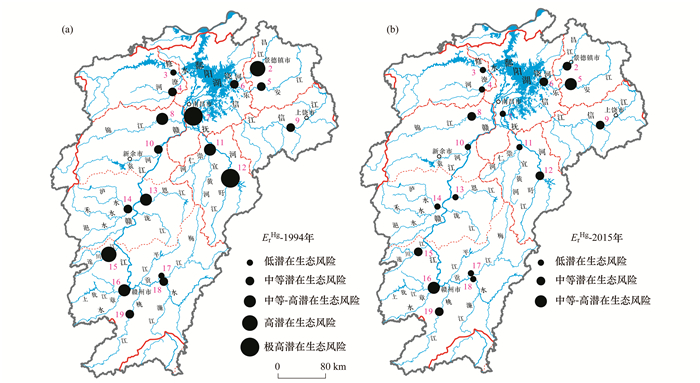
|
图 8 基于Er的鄱阳湖流域泛滥平原沉积物中Hg潜在生态风险分级 Fig. 8 Classification based on Er for mercury in floodplain sediments of the Poyang Lake basin |
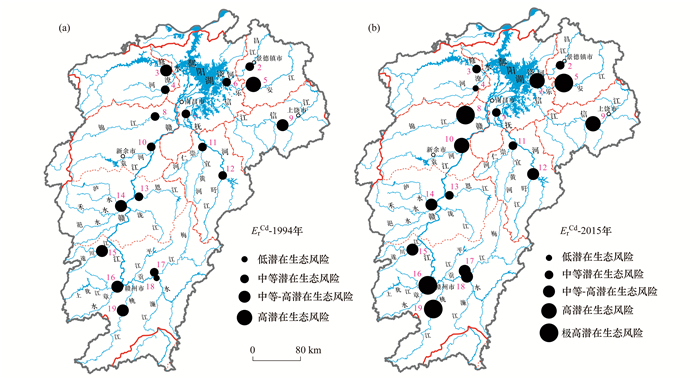
|
图 9 基于Er的鄱阳湖流域泛滥平原沉积物中Cd潜在生态风险分级 Fig. 9 Classification based on Er for cadmium in floodplain sediments of the Poyang Lake basin |
2015年微量元素的Er排序为Cd>Hg>Cu>Pb/As/Zn/Cr.其中ErCd处于31~647之间, 极高、高、中等-高、中等和低潜在生态风险点位比例分别为22%、17%、28%、28%和6%, 极高潜在生态风险点位分布于赣江和饶河乐安江, 高潜在生态风险点位于饶河下游(6号)、信江(9号)和赣江下游袁河(10号), 中等-高潜在生态风险点位主要分布于赣江上游和中游(图 9); ErHg处于23~159之间, 中等-高、中等和低潜在生态风险点位比例分别为11%、39%和50%, 中等-高潜在生态风险点位于赣江上游章水(16号)和饶河乐安江(5号)(图 8); ErCu表明饶河乐安江点位(5号)为中等潜在生态风险; Er结果显示Pb、As、Zn和Cr均为低潜在生态风险.
近20年来鄱阳湖流域引发极高和高潜在生态风险的因素由Hg变为Cd, 其点位比例发生明显变化, Hg由22%降至0, Cd由6%升至39%.
1994年, 鄱阳湖流域基于MRI的极高、高和中等生态风险点位比例分别为11%、50%和39%, 极高生态风险点位分布于抚河流域, 其高MRI贡献率元素是Hg, 高生态风险点的高MRI贡献率元素是Hg和Cd(图 10).
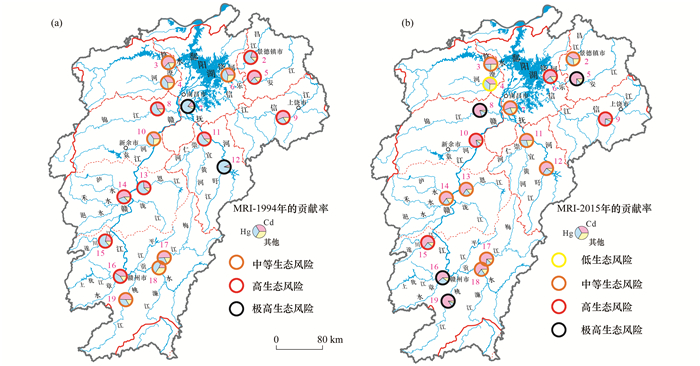
|
图 10 基于MRI的鄱阳湖流域泛滥平原沉积物中微量元素生态风险分级 Fig. 10 Classification based on MRI for selected elements in floodplain sediments of the Poyang Lake basin |
2015年, 鄱阳湖流域基于MRI的极高、高、中等和低生态风险点位比例分别为22%、22%、50%和6%, 极高生态风险点位分布于赣江和饶河流域, 极高和高生态风险点的高MRI贡献率元素是Cd(图 10).
近20年来鄱阳湖流域极高生态风险点位的比例由11%升至22%, 且均由中等和高生态风险升级而来, 其高MRI贡献率元素由Hg变为Cd; 源于Hg污染的极高生态风险点降至中等生态风险(图 10).
2.4 显著变化原因分析近20年来, 赣江、信江和饶河流域Cd含量显著升高, 其中Cd污染在赣江流域升级至中度和中度-重度, 在饶河乐安江升级至重度, 在信江升级至中度-重度.
赣江是江西省农业灌溉和工业生产的重要水源.赣州地区是具有规模开采百年历史的钨矿资源区[45], 也是我国离子型稀土资源的重要产区.经过40多年的发展, 稀土开采污染遍布赣州18个县(市、区), 涉及废弃稀土矿山302个, 遗留尾矿1.91亿t[46].相关研究表明, 赣江章水上游大余县具有百年开采历史的钨矿尾矿堆积区尾砂中Cd严重超标, 平均含量高达11 mg·kg-1[47]; 大余县4大钨矿尾砂库周边地区土壤Cd和W的平均含量高达8.88 mg·kg-1和221.35 mg·kg-1[48]. 2011~2017年, 不同时间在赣江流域采集的河流沉积物和水样均发现赣江上游高Cd的特征(表 3)[49~52], 赣江上游章水、桃江和贡水河流沉积物Cd和W平均含量分别为2.85 mg·kg-1和12.30 mg·kg-1, 分别是江西省土壤元素背景值的28.5倍和2.41倍, 尤其章水的Cd和W相对较高[53]; 赣江上游章水和桃江水体中可溶态Cd浓度在丰水期和枯水期均处于较高水平[54].调查发现大余北部山区钨矿集区周边及其下游章水冲积平原沿岸农田土壤存在以Cd和As为主的较大面积重金属复合异常区, 农田土壤中的Cd、As和W呈显著正相关[55]; 1987~2006年, 章水上游沿岸污染区的稻米Cd平均含量从0.23 mg·kg-1升至0.59 mg·kg-1, 在19年内增加了1.5倍[56].在尾矿堆积区尾砂、尾砂库周边土壤、流域内河流沉积物和水体以及河流沿岸农田土壤和作物中, 赣江上游章水流域Cd均处于较高水平; 钨矿尾砂库周边土壤和河流沉积物中W含量也远超背景值, 以上都说明赣州地区的矿产开采、尾矿库及废水排放等因素对赣江上游章水流域环境质量产生了长期深远的影响.
|
|
表 3 鄱阳湖流域及各支流多介质微量元素含量/浓度汇总1) Table 3 Summary of the statistics of multi-medium trace element concentrations of the Poyang Lake basin and tributaries |
桃江流域分布有大大小小的稀土矿区[49], 稀土矿残渣和尾矿中含有大量与稀土矿物伴生的重金属元素[57], 桃江流域某稀土尾矿区表层土壤Cd含量高达1.80 mg·kg-1[58], 某稀土矿区周边河流水体pH较低且Mn浓度远超地表水限量值, 88%的河水已不适用于农业生产[59]; 桃江上游河流沉积物和水体具有高Cd的特征[49, 52](表 3); 稀土矿开采过程释放到环境中的氨氮具有较强的络合能力, 对Cd等元素的迁移能力影响较大, 容易引发再生污染问题[60], 以上都说明桃江流域长期受到矿山开采的影响.
赣江下游袁河和锦江流经赣西萍乡-丰城矿集区, 矿集区内主要集中分布了铁矿和煤矿, 煤矿主要赋存于萍乡-丰城一带广泛出露的上二叠统乐平组和上三叠统安源组含黑色岩系的地层[61].有研究表明, 黑色岩系通常富含有机质和微量金属元素, 且含有高含量的硫化物, Cd主要赋存于硫化物组分中[62~64], 在暴露于氧气和水的环境中Cd容易释放出来, Cd的浸出会提高河流系统中Cd的浓度, 且采矿或农业生产等人为活动会加速Cd释放进入环境中[64], 多流域环境中的Cd富集主要源于黑色岩系[65, 66].袁河和锦江水体中溶解态Cd平均浓度相对较高[67], 因此黑色岩系的自然风化、采矿及农业生产活动可能会是导致赣江下游袁河和锦江Cd污染的重要因素.
信江上游是一个典型的农业区, 有效灌溉面积占信江总流域面积的79%[50]; 永平和贵溪铜矿等矿产分布在信江中游地区[70], 且流域内分布有大量的煤矿资源[61].2011年和2015年, 在信江全流域采集的河流沉积物中均发现了高含量的Cd(表 3), 研究结果表明农业生产和矿产开发等人为活动对信江流域环境造成了污染[50, 70].
饶河乐安江流域内有色金属矿产资源丰富, 流经中国最大的露天铜矿德兴铜矿区和银山铅锌矿区.近年来, 矿山开采与冶炼及酸性矿山废水排放引发的生态环境影响越来越受到人们的关注.从1990s开始至今, 已有一系列对乐安江流域包括河水[23, 71~75]、河流沉积物[15, 23, 68, 71~74, 76, 77]、泛滥平原沉积物[75, 78, 79]以及近岸农田土壤[23, 77]等介质中微量元素含量、空间分布特征及生态风险的相关研究.较早的研究可以追溯到1987年, 1987~1995年, 对河水和河流沉积物中Cu、Pb和Zn的调查研究结果表明, 矿山排放的酸性废水对河流生态系统会产生不良影响[71]; 邻近乐安江的矿山开采和冶炼活动向乐安江排放了大量酸性矿山废水, 尤其是难以控制尾矿库的非点源污染和渗漏, 会有大量的微量金属流入乐安江[77, 80].随着时间推进, 在乐安江流域开展的多时间、多介质和多指标的调查研究, 基本都显示流域环境质量不容乐观(表 3).不同时间对乐安江流域的详查结果表明, Cd和Cu是主要污染元素[15, 23, 68], Cd、Cu和Hg是生态风险的主要贡献者[15, 68], 与本文的研究结果一致.采用PMF[22, 68]、MCR-ALS[15]、MCR-WALS[22]和APCS-MLR[23]等不同污染源识别方法得出了相似的结果, 结果显示乐安江沉积物中微量金属主要是源于铜矿、铅锌矿和金矿等矿产的开采与冶炼以及农业生产等人为活动.且有研究结果表明, 污染主要源于乐安江中游大乌河和吉水河, 从元素组合特征判别污染主要源自铜矿和金矿的开采与冶炼[68].因此乐安江流域的污染在很大程度上源于近几十年来长期的矿产开发与冶炼.
大气沉降也会导致微量元素在泛滥平原富集[3]. 2010年江西省大气Cd年排放量为80.3 t, 主要排放源是铅冶炼、锌冶炼和煤燃烧, 分别占总排放量的73%、11%和9%, Cd排放量较2000年明显增加[81]; 对比中国生态系统研究网络各监测点降水中可溶微量元素的结果显示, 位于江西庐山的监测点Cd年沉降通量是全国平均值的3倍以上, 高于全国94%的监测点[82].因此大气沉降的Cd可能会是近20年来鄱阳湖流域Cd普遍升高的一个影响因素.
以上结果表明, 近20年来鄱阳湖流域污染变化的主要因素是Cd污染加剧, 污染主要源于矿产开发与冶炼、工业和农业生产等人为活动.采矿活动长期以来一直是河流系统微量金属的一个潜在来源[83], 其会向环境中释放大量微量金属, 随后这些金属被运送到下游并在洪泛区积累.如今, 泛滥平原沉积物带有流域内曾发生的采矿活动的化学印记, 为历史的采矿活动和由此产生的微量金属污染提供了一个“档案”[84].在可预见的将来, 泛滥平原沉积物可能成为河流下游微量元素污染的潜在来源, 最终汇入鄱阳湖流入长江.因此有必要在鄱阳湖流域污染变化显著的重点地区开展持续监测, 以充分了解微量元素在河流系统的积累变化过程, 评估生态风险, 为鄱阳湖流域环境保护决策提供更合理和更有效的信息.
3 结论(1) 近20年来, 鄱阳湖流域12种微量元素含量总体上增加的是Cd、Zn、Mn、W和Pb, 总体上减少的是Hg、As、Cr、Ni、Sb和Sn, Cu无明显变化.
(2) 饶河、赣江和信江流域的Cd含量显著升高, 分别升高了331%、151%和107%, 抚河、赣江和修水流域的Hg含量分别降低了87%、41%和40%.
(3) EF结果表明, 近20年来鄱阳湖流域微量元素的污染变化主要表现为Cd污染加剧和Hg污染降级, 整个赣江流域Cd污染升级至中度和中度-重度, 饶河乐安江Cd污染升级至重度, 抚河流域Hg污染降至无或轻微.
(4) MPI结果表明, 近20年来鄱阳湖流域Cd污染加剧导致综合污染升级, 极度和重度污染点位比例由17%升至33%.
(5) MRI结果显示, 近20年来鄱阳湖流域极高生态风险点位的比例由11%升至22%, 其高MRI贡献率元素由Hg变为Cd, 源于Hg污染的极高生态风险点降至中等生态风险.
(6) 鄱阳湖流域泛滥平原沉积物中微量元素的显著污染变化主要源于矿产开发与冶炼、工业和农业生产等人为活动.
| [1] | Lair G J, Zehetner F, Fiebig M, et al. How do long-term development and periodical changes of river-floodplain systems affect the fate of contaminants? results from European rivers[J]. Environmental Pollution, 2009, 157(12): 3336-3346. DOI:10.1016/j.envpol.2009.06.004 |
| [2] | Viers J, DupréB, Gaillardet J. Chemical composition of suspended sediments in World Rivers: new insights from a new database[J]. Science of the Total Environment, 2009, 407(2): 853-868. DOI:10.1016/j.scitotenv.2008.09.053 |
| [3] | Du Laing G, Rinklebe J, Vandecasteele B, et al. Trace metal behaviour in estuarine and riverine floodplain soils and sediments: a review[J]. Science of the Total Environment, 2009, 407(13): 3972-3985. DOI:10.1016/j.scitotenv.2008.07.025 |
| [4] | Tockner K, Stanford J A. Riverine flood plains: present state and future trends[J]. Environmental Conservation, 2002, 29(3): 308-330. DOI:10.1017/S037689290200022X |
| [5] | Rennert T, Rabus W, Rinklebe J. Modelling the concentrations of dissolved contaminants (Cd, Cu, Ni, Pb, Zn) in floodplain soils[J]. Environmental Geochemistry and Health, 2017, 39(2): 331-344. DOI:10.1007/s10653-016-9859-4 |
| [6] | Zhuang Q F, Li G, Liu Z Y. Distribution, source and pollution level of heavy metals in river sediments from South China[J]. CATENA, 2018, 170: 386-396. DOI:10.1016/j.catena.2018.06.037 |
| [7] | Grosbois C, Meybeck M, Horowitz A, et al. The spatial and temporal trends of Cd, Cu, Hg, Pb and Zn in Seine River floodplain deposits (1994-2000)[J]. Science of the Total Environment, 2006, 356(1-3): 22-37. DOI:10.1016/j.scitotenv.2005.01.049 |
| [8] | Martin C W. Trace metal storage in recent floodplain sediments along the Dill River, central Germany[J]. Geomorphology, 2015, 235: 52-62. DOI:10.1016/j.geomorph.2015.01.032 |
| [9] | Bhatti S S, Kumar V, Kumar A, et al. Potential ecological risks of metal(loid)s in riverine floodplain soils[J]. Ecotoxicology and Environmental Safety, 2018, 164: 722-731. DOI:10.1016/j.ecoenv.2018.08.032 |
| [10] | Collins A L, Walling D E, Leeks G J L. Use of the geochemical record preserved in floodplain deposits to reconstruct recent changes in river basin sediment sources[J]. Geomorphology, 1997, 19(1-2): 151-167. DOI:10.1016/S0169-555X(96)00044-X |
| [11] |
成杭新, 谢学锦. 泛滥平原沉积物的超低密度采样代表性研究(一)[J]. 长春地质学院学报, 1997, 27(3): 289-295. Cheng H X, Xie X J. Research on representativity sampling of floodplain sediments[J]. Journal of Changchun University of Earth Sciences, 1997, 27(3): 289-295. |
| [12] |
成杭新, 谢学锦. 泛滥平原沉积物的超低密度采样代表性研究(二): 统计学检验及地质意义[J]. 有色金属矿产与勘查, 1997, 6(4): 238-242. Cheng H X, Xie X J. Representativity of wide-spaced floodplain sediment sampling: its statistical test and geological significance[J]. Geological Exploration for Non-Ferrous Metals, 1997, 6(4): 238-242. |
| [13] | Xie X J, Cheng H X. The suitability of floodplain sediment as a global sampling medium: evidence from China[J]. Journal of Geochemical Exploration, 1997, 58(1): 51-62. DOI:10.1016/S0375-6742(96)00051-9 |
| [14] | Xie X J, Cheng H X. Global geochemical mapping and its implementation in the Asia-Pacific region[J]. Applied Geochemistry, 2001, 16(11-12): 1309-1321. DOI:10.1016/S0883-2927(01)00051-8 |
| [15] | Chen H Y, Chen R H, Teng Y G, et al. Contamination characteristics, ecological risk and source identification of trace metals in sediments of the Le'an River (China)[J]. Ecotoxicology and Environmental Safety, 2016, 125: 85-92. DOI:10.1016/j.ecoenv.2015.11.042 |
| [16] | Yuan G L, Liu C, Chen L, et al. Inputting history of heavy metals into the inland lake recorded in sediment profiles: Poyang Lake in China[J]. Journal of Hazardous Materials, 2011, 185(1): 336-345. DOI:10.1016/j.jhazmat.2010.09.039 |
| [17] | Zhang H, Jiang Y H, Ding M J, et al. Level, source identification, and risk analysis of heavy metal in surface sediments from river-lake ecosystems in the Poyang Lake, China[J]. Environmental Science and Pollution Research, 2017, 24(27): 21902-21916. DOI:10.1007/s11356-017-9855-y |
| [18] | Dai L J, Wang L Q, Li L F, et al. Multivariate geostatistical analysis and source identification of heavy metals in the sediment of Poyang Lake in China[J]. Science of the Total Environment, 2018, 621: 1433-1444. DOI:10.1016/j.scitotenv.2017.10.085 |
| [19] | Luo M B, Li J Q, Cao W P, et al. Study of heavy metal speciation in branch sediments of Poyang Lake[J]. Journal of Environmental Sciences, 2008, 20(2): 161-166. DOI:10.1016/S1001-0742(08)60025-X |
| [20] | Yan F, Liu C L, Wei B W. Evaluation of heavy metal pollution in the sediment of Poyang Lake based on stochastic geo-accumulation model (SGM)[J]. Science of the Total Environment, 2019, 659: 1-6. DOI:10.1016/j.scitotenv.2018.12.311 |
| [21] | Wang H, Zhao Y J, Liang D F, et al. 30+year evolution of Cu in the surface sediment of Lake Poyang, China[J]. Chemosphere, 2017, 168: 1604-1612. DOI:10.1016/j.chemosphere.2016.11.149 |
| [22] | Chen H Y, Teng Y G, Li J, et al. Source apportionment of trace metals in river sediments: a comparison of three methods[J]. Environmental Pollution, 2016, 211: 28-37. DOI:10.1016/j.envpol.2015.12.037 |
| [23] | Zhang H, Zeng H, Jiang Y H, et al. Using the compound system to synthetically evaluate the enrichment of heavy metal(loid)s in a subtropical basin, China[J]. Environmental Pollution, 2020, 256. DOI:10.1016/j.envpol.2019.113396 |
| [24] | Xie Z L, Jiang Y H, Zhang H Z, et al. Assessing heavy metal contamination and ecological risk in Poyang Lake area, China[J]. Environmental Earth Sciences, 2016, 75(7). DOI:10.1007/s12665-015-5240-7 |
| [25] |
匡荟芬, 胡春华, 吴根林, 等. 结合主成分分析法(PCA)和正定矩阵因子分解法(PMF)的鄱阳湖丰水期表层沉积物重金属源解析[J]. 湖泊科学, 2020, 32(4): 964-976. Kuang H F, Hu C H, Wu G L, et al. Combination of PCA and PMF to apportion the sources of heavy metals in surface sediments from Lake Poyang during the wet season[J]. Journal of Lake Sciences, 2020, 32(4): 964-976. |
| [26] |
弓晓峰, 陈春丽, 周文斌, 等. 鄱阳湖底泥中重金属污染现状评价[J]. 环境科学, 2006, 27(4): 732-736. Gong X F, Chen C L, Zhou W B, et al. Assessment on heavy metal pollution in the sediment of Poyang Lake[J]. Environmental Science, 2006, 27(4): 732-736. DOI:10.3321/j.issn:0250-3301.2006.04.025 |
| [27] |
伍恒赟, 罗勇, 张起明, 等. 鄱阳湖沉积物重金属空间分布及潜在生态风险评价[J]. 中国环境监测, 2014, 30(6): 114-119. Wu H Y, Luo Y, Zhang Q M, et al. Spatial distribution and potential ecological risk assessment of heavy metals in sediments of Poyang Lake[J]. Environmental Monitoring in China, 2014, 30(6): 114-119. DOI:10.3969/j.issn.1002-6002.2014.06.019 |
| [28] |
简敏菲, 李玲玉, 徐鹏飞, 等. 鄱阳湖-乐安河湿地水土环境中重金属污染的时空分布特征[J]. 环境科学, 2014, 35(5): 1759-1765. Jian M F, Li L Y, Xu P F, et al. Spatiotemporal variation characteristics of heavy metals pollution in the water, soil and sediments environment of the Lean River-Poyang Lake wetland[J]. Environmental Science, 2014, 35(5): 1759-1765. |
| [29] |
杨期勇, 曾明, 谢琪, 等. 鄱阳湖北部湖区沉积物重金属分布及其潜在生态风险评价[J]. 生态环境学报, 2018, 27(3): 556-564. Yang Q Y, Zeng M, Xie Q, et al. The distribution of heavy metals and potential ecological risk in the Northern Poyang Lake[J]. Ecology and Environmental Sciences, 2018, 27(3): 556-564. |
| [30] |
王岚, 王亚平, 许春雪, 等. 长江水系表层沉积物重金属污染特征及生态风险性评价[J]. 环境科学, 2012, 33(8): 2599-2606. Wang L, Wang Y P, Xu C X, et al. Pollution characteristics and ecological risk assessment of heavy metals in the surface sediments of the Yangtze River[J]. Environmental Science, 2012, 33(8): 2599-2606. |
| [31] |
李文明, 杨忠芳, 周雷, 等. 鄱阳湖水系重金属元素地球化学特征及入湖通量[J]. 现代地质, 2014, 28(3): 512-522. Li W M, Yang Z F, Zhou L, et al. Geochemical characteristic and fluxes of heavy metals in water system of the Poyang Lake[J]. Geoscience, 2014, 28(3): 512-522. DOI:10.3969/j.issn.1000-8527.2014.03.007 |
| [32] |
成杭新, 严光生, 沈夏初, 等. 化学定时炸弹: 中国陆地环境面临的新问题[J]. 长春科技大学学报, 1999, 29(1): 68-73. Cheng H X, Yan G S, Shen X C, et al. Chemical time bomb: a new problem faced by China's terrene environment[J]. Journal of Changchun University of Science and Technology, 1999, 29(1): 68-73. |
| [33] | Zheng K L, Ye J Y, Jiang B L. Selected analytical methods of 57 elements for multi-purpose geochemical survey[M]. Beijing: Geological Publishing House, 2005. |
| [34] | Rahn K A, Mccaffrey R J. Compositional differences between Arctic aerosol and snow[J]. Nature, 1979, 280(5722): 479-480. DOI:10.1038/280479a0 |
| [35] | 中国环境监测总站. 中国土壤元素背景值[M]. 北京: 中国环境科学出版社, 1990. |
| [36] | Sutherland R A. Bed sediment-associated trace metals in an urban stream, Oahu, Hawaii[J]. Environmental Geology, 2000, 39(6): 611-627. DOI:10.1007/s002540050473 |
| [37] | Brady J P, Ayoko G A, Martens W N, et al. Development of a hybrid pollution index for heavy metals in marine and estuarine sediments[J]. Environmental Monitoring and Assessment, 2015, 187(5). DOI:10.1007/s10661-015-4563-x |
| [38] | Karageorgis A P, Botsou F, Kaberi H, et al. Geochemistry of major and trace elements in surface sediments of the Saronikos Gulf (Greece): assessment of contamination between 1999 and 2018[J]. Science of the Total Environment, 2020, 717. DOI:10.1016/j.scitotenv.2020.137046 |
| [39] | Martínez-Guijarro R, Paches M, Romero I, et al. Enrichment and contamination level of trace metals in the Mediterranean marine sediments of Spain[J]. Science of the Total Environment, 2019, 693. DOI:10.1016/j.scitotenv.2019.07.372 |
| [40] | Loring D H. Normalization of heavy-metal data from estuarine and coastal sediments[J]. ICES Journal of Marine Science, 1991, 48(1): 101-115. DOI:10.1093/icesjms/48.1.101 |
| [41] | Håkanson L. An ecological risk index for aquatic pollution control.a sedimentological approach[J]. Water Research, 1980, 14(8): 975-1001. DOI:10.1016/0043-1354(80)90143-8 |
| [42] | Duodu G O, Goonetilleke A, Ayoko G A. Comparison of pollution indices for the assessment of heavy metal in Brisbane River sediment[J]. Environmental Pollution, 2016, 219: 1077-1091. DOI:10.1016/j.envpol.2016.09.008 |
| [43] | Yavar Ashayeri N, Keshavarzi B. Geochemical characteristics, partitioning, quantitative source apportionment, and ecological and health risk of heavy metals in sediments and water: a case study in Shadegan Wetland, Iran[J]. Marine Pollution Bulletin, 2019, 149. DOI:10.1016/j.marpolbul.2019.110495 |
| [44] | Yi Y J, Yang Z F, Zhang S H. Ecological risk assessment of heavy metals in sediment and human health risk assessment of heavy metals in fishes in the middle and lower reaches of the Yangtze River basin[J]. Environmental Pollution, 2011, 159(10): 2575-2585. DOI:10.1016/j.envpol.2011.06.011 |
| [45] |
陈明, 杨涛, 徐慧, 等. 赣南某钨矿区土壤中Cd、Pb的形态特征及生态风险评价[J]. 环境化学, 2015, 34(12): 2257-2262. Chen M, Yang T, Xu H, et al. Distribution characteristics and ecological risk assessment of heavy metals Cd and Pb in soils around a tungsten mine of Gannan[J]. Environmental Chemistry, 2015, 34(12): 2257-2262. DOI:10.7524/j.issn.0254-6108.2015.12.2015070201 |
| [46] |
蔡奇英, 刘以珍, 管毕财, 等. 南方离子型稀土矿的环境问题及生态重建途径[J]. 国土与自然资源研究, 2013(5): 52-54. Cai Q Y, Liu Y Z, Guan B C, et al. Environmental issues and ecological restoration of ion-absorbed-type rare earth deposit in South China[J]. Territory & Natural Resources Study, 2013(5): 52-54. DOI:10.3969/j.issn.1003-7853.2013.05.018 |
| [47] |
刘丹, 赵永红, 周丹, 等. 赣南某钨矿区土壤重金属污染生态风险评价[J]. 环境化学, 2017, 36(7): 1556-1567. Liu D, Zhao Y H, Zhou D, et al. Ecological risk assessment of heavy metals pollution in a tungsten mine soil in south of Jiangxi Province[J]. Environmental Chemistry, 2017, 36(7): 1556-1567. |
| [48] |
刘足根, 杨国华, 杨帆, 等. 赣南钨矿区土壤重金属含量与植物富集特征[J]. 生态学杂志, 2008, 27(8): 1345-1350. Liu Z G, Yang G H, Yang F, et al. Soil heavy metals concentrations and their enrichment characteristics by plants in tungsten mine areas of South Jiangxi[J]. Chinese Journal of Ecology, 2008, 27(8): 1345-1350. |
| [49] |
陈明, 李凤果, 陶美霞, 等. 赣南典型矿区河流上覆水与表层沉积物重金属分布特征及风险评价[J]. 环境化学, 2019, 38(7): 1461-1469. Chen M, Li F G, Tao M X, et al. Distribution characteristics and risk assessment of heavy metals in overlying water and surface sediments in rivers in typical mining areas of southern Jiangxi Province[J]. Environmental Chemistry, 2019, 38(7): 1461-1469. |
| [50] | Xu J Y, Xu L G, Zheng L L, et al. Distribution, risk assessment, and source analysis of heavy metals in sediment of rivers located in the hilly area of southern China[J]. Journal of Soils and Sediments, 2019, 19(10): 3608-3619. DOI:10.1007/s11368-019-02341-3 |
| [51] | Ji Y, Zhang J, Huang X P, et al. Investigation and assessment of heavy metals in surface sediments of Ganjiang River, China[J]. Journal of Environmental Biology, 2014, 35(6): 1173-1179. |
| [52] | Chen M, Li F G, Tao M X, et al. Distribution and ecological risks of heavy metals in river sediments and overlying water in typical mining areas of China[J]. Marine Pollution Bulletin, 2019, 146: 893-899. DOI:10.1016/j.marpolbul.2019.07.029 |
| [53] |
李凤果, 陈明, 师艳丽, 等. 赣江上游沉积物重金属空间分布及污染特征[J]. 生态学杂志, 2020, 39(3): 920-927. Li F G, Chen M, Shi Y L, et al. Spatial distribution and pollution characteristics of heavy metals in sediments of the upper reaches of Ganjiang River[J]. Chinese Journal of Ecology, 2020, 39(3): 920-927. |
| [54] |
张宝军, 朱蒙曼, 王鹏, 等. 赣江流域水体中可溶态镉的时空分布特征及水质评价[J]. 生态与农村环境学报, 2014, 30(4): 495-499. Zhang B J, Zhu M M, Wang P, et al. Spatial and temporal distribution of dissolved cadmium in and water quality assessment of the water body of the Ganjiang River Catchment[J]. Journal of Ecology and Rural Environment, 2014, 30(4): 495-499. DOI:10.3969/j.issn.1673-4831.2014.04.014 |
| [55] |
文帮勇, 黄锦, 张涛亮, 等. 赣南大余地区农田土壤As、Cd元素化学形态含量分析[J]. 资源调查与环境, 2015, 36(4): 298-305. Wen B Y, Huang J, Zhang T L, et al. Geochemical speciation analysis of As and Cd in farmland soil in Dayu County, southern Jiangxi Province[J]. Resources Survey and Environment, 2015, 36(4): 298-305. DOI:10.3969/j.issn.1671-4814.2015.04.009 |
| [56] | Zhang W L, Du Y, Zhai M M, et al. Cadmium exposure and its health effects: a 19-year follow-up study of a polluted area in China[J]. Science of the Total Environment, 2014, 470-471: 224-228. DOI:10.1016/j.scitotenv.2013.09.070 |
| [57] |
郭钟群, 赵奎, 金解放, 等. 离子型稀土矿环境风险评估及污染治理研究进展[J]. 稀土, 2019, 40(3): 115-126. Guo Z Q, Zhao K, Jin J F, et al. Reviews on environmental assessment and pollution prevention of ion adsorption type rare earth ores[J]. Chinese Rare Earths, 2019, 40(3): 115-126. |
| [58] | Zheng T H, Yang J, Huang P F, et al. Comparison of trace element pollution, sequential extraction, and risk level in different depths of tailings with different accumulation age from a rare earth mine in Jiangxi Province, China[J]. Journal of Soils and Sediments, 2018, 18(3): 992-1002. DOI:10.1007/s11368-017-1853-7 |
| [59] | Hao X Z, Wang D J, Wang P R, et al. Evaluation of water quality in surface water and shallow groundwater: a case study of a rare earth mining area in southern Jiangxi Province, China[J]. Environmental Monitoring and Assessment, 2016, 188(1). DOI:10.1007/s10661-015-5025-1 |
| [60] |
高志强, 周启星. 稀土矿露天开采过程的污染及对资源和生态环境的影响[J]. 生态学杂志, 2011, 30(12): 2915-2922. Gao Z Q, Zhou Q X. Contamination from rare earth ore strip mining and its impacts on resources and eco-environment[J]. Chinese Journal of Ecology, 2011, 30(12): 2915-2922. |
| [61] | 《中国矿产地质志》项目办公室. 中国矿产地质志《江西卷上》[M]. 北京: 地质出版社, 2015. |
| [62] | Perkins R B, Mason C E. The relative mobility of trace elements from short-term weathering of a black shale[J]. Applied Geochemistry, 2015, 56: 67-79. DOI:10.1016/j.apgeochem.2015.01.014 |
| [63] | Lavergren U, Åstr öm M E, Bergbäck B, et al. Mobility of trace elements in black shale assessed by leaching tests and sequential chemical extraction[J]. Geochemistry: Exploration, Environment, Analysis, 2009, 9(1): 71-79. DOI:10.1144/1467-7873/08-188 |
| [64] | Liu Y Z, Xiao T F, Perkins R B, et al. Geogenic cadmium pollution and potential health risks, with emphasis on black shale[J]. Journal of Geochemical Exploration, 2017, 176: 42-49. DOI:10.1016/j.gexplo.2016.04.004 |
| [65] |
杨东, 李方林, 夏锦霞, 等. 清江流域水系中高Cd沉积物的物源浅析[J]. 地质科技情报, 2009, 28(1): 99-104. Yang D, Li F L, Xia J X, et al. Sources analysis of Cd in Qingjiang stream sediment, Hubei Province[J]. Geological Science and Technology Information, 2009, 28(1): 99-104. DOI:10.3969/j.issn.1000-7849.2009.01.016 |
| [66] | Qu S Y, Wu W H, Nel W, et al. The behavior of metals/metalloids during natural weathering: a systematic study of the mono-lithological watersheds in the upper Pearl River Basin, China[J]. Science of the Total Environment, 2020, 708. DOI:10.1016/j.scitotenv.2019.134572 |
| [67] |
李传琼, 王鹏, 陈波, 等. 鄱阳湖流域赣江水系溶解态金属元素空间分布特征及污染来源[J]. 湖泊科学, 2018, 30(1): 139-149. Li C Q, Wang P, Chen B, et al. Spatial distribution and pollution source of dissolved metals in the Ganjiang River of Lake Poyang Basin[J]. Journal of Lake Sciences, 2018, 30(1): 139-149. |
| [68] | Li J, Song L T, Chen H Y, et al. Source apportionment of potential ecological risk posed by trace metals in the sediment of the Le'an River, China[J]. Journal of Soils and Sediments, 2020, 20(5): 2460-2470. DOI:10.1007/s11368-020-02604-4 |
| [69] | Xu J Y, Zheng L L, Xu L G, et al. Identification of dissolved metal contamination of major rivers in the southeastern hilly area, China: distribution, source apportionment, and health risk assessment[J]. Environmental Science and Pollution Research, 2020, 27(4): 3908-3922. DOI:10.1007/s11356-019-06774-8 |
| [70] | Ji Y, Zhang J, Li R H, et al. Distribution and partitioning of heavy metals in sediments of the Xinjiang River in Poyang Lake Region, China[J]. Environmental Progress & Sustainable Energy, 2015, 34(3): 713-723. |
| [71] | He M C, Wang Z J, Tang H X. Spatial and temporal patterns of acidity and heavy metals in predicting the potential for ecological impact on the Le An river polluted by acid mine drainage[J]. Science of the Total Environment, 1997, 206(1): 67-77. DOI:10.1016/S0048-9697(97)00217-9 |
| [72] | He M C, Wang Z J, Tang H X. The chemical, toxicological and ecological studies in assessing the heavy metal pollution in Le An River, China[J]. Water Research, 1998, 32(2): 510-518. DOI:10.1016/S0043-1354(97)00229-7 |
| [73] | Xiao H Y, Zhou W B, Zeng F P, et al. Water chemistry and heavy metal distribution in an AMD highly contaminated river[J]. Environmental Earth Sciences, 2010, 59(5): 1023-1031. DOI:10.1007/s12665-009-0094-5 |
| [74] |
余杨, 吕雅宁, 王伟杰, 等. 乐安河中下游重金属时空分布特征及风险评价[J]. 环境科学, 2020, 41(2): 691-701. Yu Y, LüY N, Wang W J, et al. Spatio-temporal distribution and risk assessment of heavy metals in middle and lower reaches of Le'an River[J]. Environmental Science, 2020, 41(2): 691-701. |
| [75] | Liu W X, Coveney R M, Chen J L. Environmental quality assessment on a river system polluted by mining activities[J]. Applied Geochemistry, 2003, 18(5): 749-764. DOI:10.1016/S0883-2927(02)00155-5 |
| [76] | Wen X H, Allen H E. Mobilization of heavy metals from Le An River sediment[J]. Science of the Total Environment, 1999, 227(2-3): 101-108. DOI:10.1016/S0048-9697(99)00002-9 |
| [77] | Liu W X, Wang Z J, Wen X H, et al. The application of preliminary sediment quality criteria to metal contamination in the Le An River[J]. Environmental Pollution, 1999, 105(3): 355-366. DOI:10.1016/S0269-7491(99)00041-X |
| [78] |
曾凡萍, 肖化云, 周文斌. 乐安江河滩表层土中重金属的分布和残留分析[J]. 环境科学与技术, 2009, 32(2): 96-101. Zeng F P, Xiao H Y, Zhou W B. Distribution and retention of heavy metals in floodplain topsoils of Le'an River[J]. Environmental Science & Technology, 2009, 32(2): 96-101. DOI:10.3969/j.issn.1003-6504.2009.02.024 |
| [79] | Liang Y, Xiao H, Liu X, et al. The risk and phytotoxicity of metal(loid)s in the sediment, floodplain soil, and hygrophilous grasses along Le'an River[J]. International Journal of Environmental Science and Technology, 2020, 17(4): 1963-1974. DOI:10.1007/s13762-019-02592-0 |
| [80] | Teng Y G, Ni S J, Wang J S, et al. Geochemical baseline of trace elements in the sediment in Dexing area, South China[J]. Environmental Geology, 2009, 57(7): 1649-1660. DOI:10.1007/s00254-008-1446-2 |
| [81] | Shao X, Cheng H G, Li Q, et al. Anthropogenic atmospheric emissions of cadmium in China[J]. Atmospheric Environment, 2013, 79: 155-160. DOI:10.1016/j.atmosenv.2013.05.055 |
| [82] | Zhu J X, Wang Q F, Yu H L, et al. Heavy metal deposition through rainfall in Chinese natural terrestrial ecosystems: evidences from national-scale network monitoring[J]. Chemosphere, 2016, 164: 128-133. DOI:10.1016/j.chemosphere.2016.08.105 |
| [83] | Martin C W. Trace metal concentrations along tributary streams of historically mined areas, Lower Lahn and Dill River basins, central Germany[J]. CATENA, 2019, 174: 174-183. DOI:10.1016/j.catena.2018.11.008 |
| [84] | Hürkamp K, Raab T, Völkel J. Lead pollution of floodplain soils in a historic mining area-age, distribution and binding forms[J]. Water, Air, and Soil Pollution, 2009, 201(1-4): 331-345. DOI:10.1007/s11270-008-9948-9 |
 2021, Vol. 42
2021, Vol. 42


